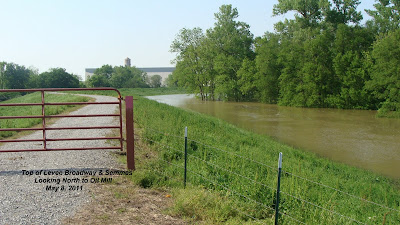








Artificial levees require substantial engineering. Their surface must be protected from erosion, so they are planted with vegetation such as Bermuda grass in order to bind the earth together. On the land side of high levees, a low terrace of earth known as a banquette is usually added as another anti-erosion measure. On the river side, erosion from strong waves or currents presents an even greater threat to the integrity of the levee. The effects of erosion are countered by planting with willows, weighted matting or concrete revetments. Separate ditches or drainage tiles are constructed to ensure that the foundation does not become waterlogged.
Levees are usually built by piling earth on a cleared, level surface. Broad at the base, they taper to a level top, where temporary embankments or sandbags can be placed. Because flood discharge intensity increases in levees on both river banks, and because silt deposits raise the level of riverbeds, planning and auxiliary measures are vital. Sections are often set back from the river to form a wider channel, and flood valley basins are divided by multiple levees to prevent a single breach from flooding a large area.

( my childhood home was to the immediate left of this pic )
(KEEP IN MIND THAT THE LEVEE HEIGHT HERE IS APPROXIMATELY 52 ft)
The Mississippi levee system represents one of the largest such systems found anywhere in the world. It comprises over 3,500 miles (5,600 km) of levees extending some 1,000 kilometres (620 mi) along the Mississippi, stretching from Cape Girardeau, Missouri to the Mississippi Delta. They were begun by French settlers in Louisiana in the 18th century to protect the city of New Orleans. The first Louisianan levees were about 3 feet (0.91 m) high and covered a distance of about 50 miles (80 km) along the riverside. By the mid-1980s, they had reached their present extent and averaged 24 feet (7.3 m) in height; some Mississippi levees are as much as 50 feet (15 m) high. The Mississippi levees also include some of the longest continuous individual levees in the world. One such levee extends southwards from Pine Bluff, Arkansas for a distance of some 380 miles (610 km).
**These pictures were taken yesterday by my brother from atop the levee close to our childhood home place. I have only seen the river this high once in my lifetime. Please join me with with your thoughts and prayers for this area of our Great United States.
Thanks for stopping by the farmhouse today. We love having company.
Au revoir,
**photo credits: Voy Gillentine
